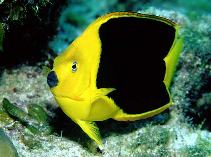| Holacanthus tricolor (Bloch, 1795) | ||||
| Family: | Pomacanthidae (Angelfishes) |
picture (Hotri_u4.jpg) by
Minguell, C.
Map |
||
| Order: | Perciformes (perch-likes) | |||
| Class: | Actinopterygii (ray-finned fishes) | |||
| FishBase name: | Rock beauty | |||
| Max. size: | 35.0 cm Total Length (male/unsexed; Ref. 3797) | |||
| Environment: | reef-associated; non-migratory; marine ; depth range 3 - 92 m | |||
| Climate: | tropical; 32°N - 33°S | |||
| Importance: | fisheries: minor commercial; aquarium: commercial | |||
| Resilience: | Medium, minimum population doubling time 1.4 - 4.4 years (Preliminary K and tmax.) | |||
| Distribution: Gazetteer |
Western Atlantic: Georgia (USA), Bermuda, and northern Gulf of Mexico to Rio de Janeiro, Brazil. | |||
| Diagnosis: | Dorsal spines (total): 14-14; Dorsal soft rays (total): 17-19; Anal spines: 3-3; Anal soft rays: 18-20. Front of body yellow; remaining parts of body, dorsal fin, and front of anal fin black. Caudal fin entirely yellow (Ref. 26938). Front margin of anal fin and edge of gill cover orange; bright blue on upper and lower part of iris. The young of about an inch in length are entirely yellow except for a blue-edged black spot on the upper side of the body posterior to the midpoint; with growth the black spot soon expands to become the large black area covering most of the body and dorsal and anal fins (Ref. 13442). | |||
| Biology: | Inhabits rock jetties, rocky reefs and rich coral areas. Juveniles often associated with fire corals (Ref. 9710). Feeds on tunicates, sponges, zoantharians and algae. Marketed fresh (Ref. 3797). | |||
| Red List Status: | Not in IUCN Red List , (Ref. 36508) | |||
| Dangerous: | reports of ciguatera poisoning , Olsen, D.A., D.W. Nellis and R.S. Wood. 1984 | |||
| Coordinator: | ||||
| Main Ref: | Allen, G.R.. 1985. (Ref. 4858) | |||
|
Update | Add | Get XML file | Point data in XML | Common names in XML |
||||